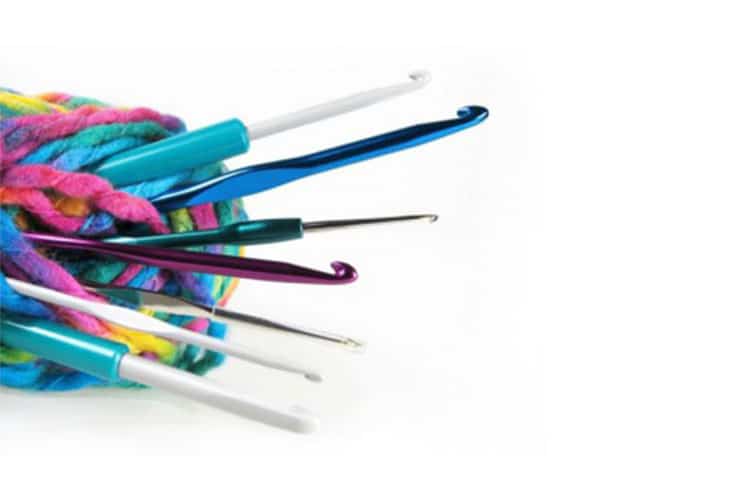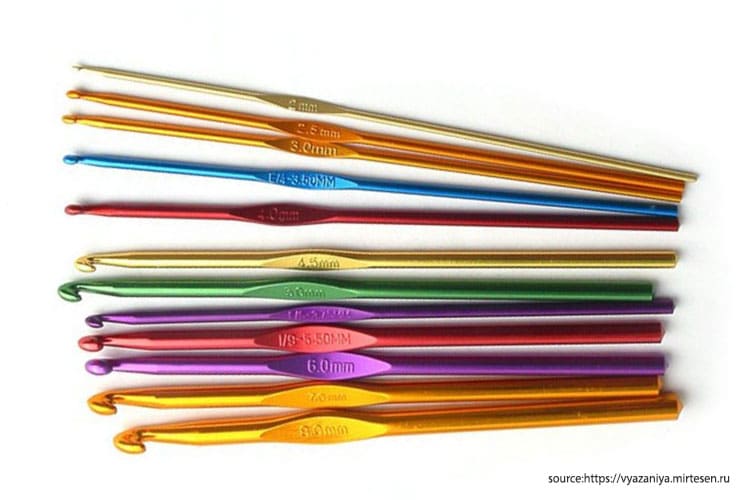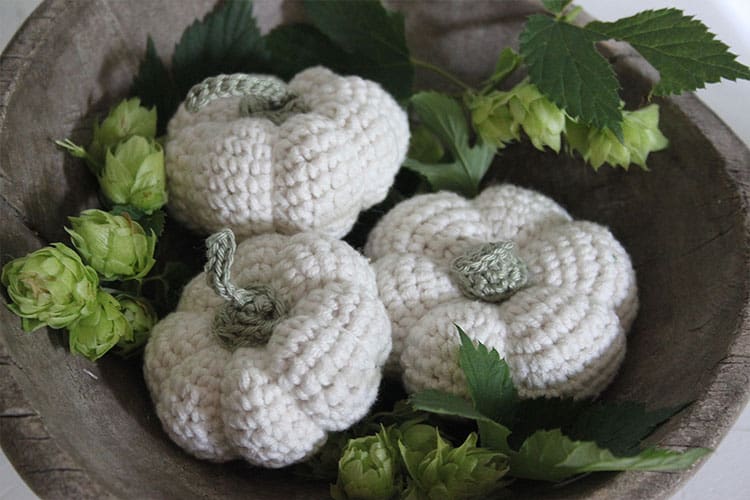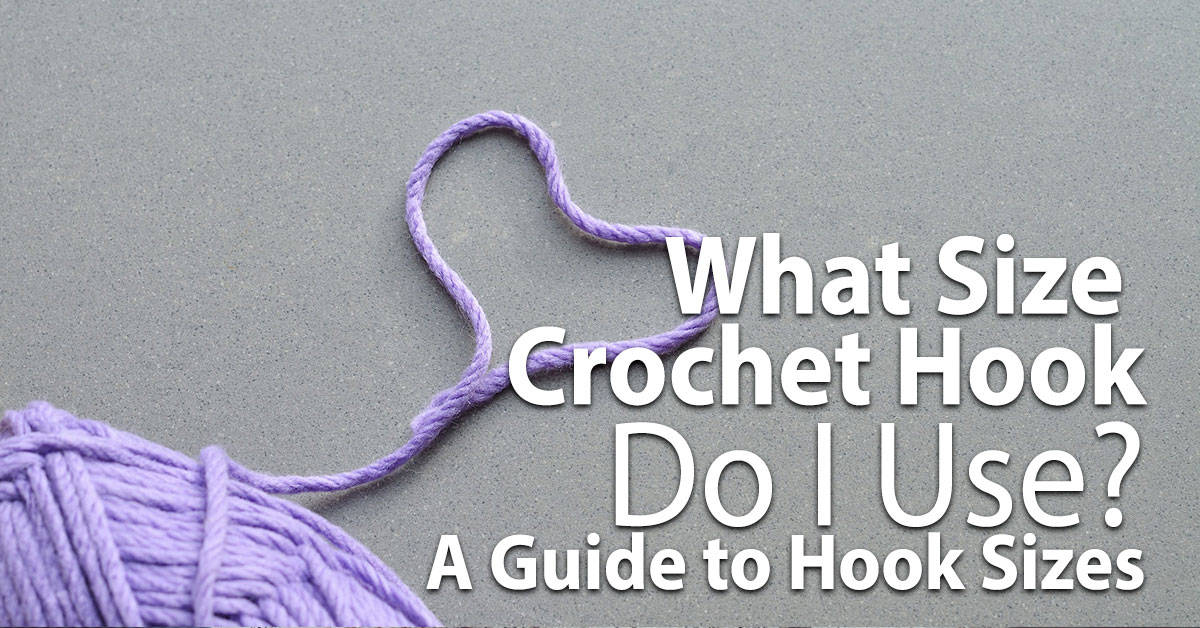So you saw the cutest little crochet teddy bear online and you say to yourself, “I can totally do that.” Then you realize that crocheting isn’t as simple as moving a needle back and forth on a piece of yarn. But you figure, what the heck, let’s go all in!
Where do you start? Well, gathering the right equipment is a great place to begin, starting with choosing the proper needle. There are multiple hook sizes and they all serve various purposes.
Let’s hash it out and you’ll be on your way to teddy bear cuteness in no time!
Hook Sizes

Let’s start by looking at this simple chart. Here you have a simplified list of hook sizes, ranging from 2.25 mm all the way up to 25mm.
Now if you’ve done a bit of research online, you would have come across hook sizes that are identified by either a letter or a numerical measurement. Don’t let this confuse you. The letter corresponds to the diameter in millimeters of the hook’s shaft. (That flat or tapered part of the hook just underneath the head).
Dia. Size
| Dia. Size
|
Choosing the Right Size

So why does size matter? To put it simply (and keeping this PG), the size of your hook will determine how big your stitches will be and that size is chosen by the thickness of your yarn. A skinny hook, say a B-1 hook, will work best with a thread-like yarn. While a U hook will work with best bulky or chunky yarn.
The sized hook you use can also depend on your crocheting abilities. Assuming you are a beginner, it is best for you to use a larger size to practice with. The shaft and hook will be larger, allowing you to easily grab and work the yarn.
Essentially, your hand has to learn a whole new set of motor functions when learning to crochet. You are already awkwardly turning your hand and wrist to get the right movement. So imagine having a smaller hook that insists on slipping underneath the yarn instead of grabbing it.
Who wants that stress!?
We can avoid it altogether and practice with a larger hook like N/P-15 (size 10). Remember, this is just to practice with. Unless your project requires bigger stitching, I do not suggest making anything specific.
“But what if I have a project in mind? Which hook is best for my piece?” Good question! Let’s break it down.
Hooks B – F
These hooks are the smallest regular hooks available and are often used with super fine yarn or baby yarn. It is common for super fine yarn to be used for lace projects, baby clothing, or any lightweight patterns that require tighter stitching.
That doesn’t mean that they cannot be used for bigger projects like sweaters or backpacks, but if you want a closer stitch, these are your go-to guys. From socks to accessories and even tightly stitched hats, pair these hooks with super fine yarn and you won’t be displeased.
*NOTE*
If you are working from a pattern, USE THE SIZED HOOK THE PATTERN CALLS FOR. If you use any other size, you can guarantee that your final product will look far different than what you expected.
Don’t say I didn’t warn you.
Hooks G – H
Hooks G and H are your lightweights. They handle the breezy, feathery projects like flimsy scarves or breezy sweaters. When using these types of hooks, your stitches tend to be looser and spacious allowing the stitched fabric to breathe.
Think of a nice spring day, where the wind is blowing just right. It’s not too hot, it’s not too cold. A cute, light body length sweater would be the perfect addition to your outfit.
*NOTE* Again, if your project is meant to be lightweight and the pattern calls for a 7 hook, use a 7! I cannot stress this enough.
Hooks I and J
We typically see hooks I and J being called upon for projects like afghans, blankets or typical hats. With a wider diameter, the stitching is certainly larger as is the yarn required.
Medium weight yarn stands in that sweet spot between tiny and huge. You can get delicate-looking stitches without needing to strain your wrist or hand, and grabbing the yarn is less difficult.
Now, N/P-15 isn’t a bad choice for a beginner practice hook, but I or J is not a bad start either.
Hook K
The K hook seems to be the only hook that is appropriate for those projects that use yarn in between medium and bulky weight. It gives you that delicate stitching that hooks I and J provide, but opts for a lot more spacing.
While the stitches aren’t exactly tight, I wouldn’t consider them loose either. Your projects tend to be a bit heavier and sturdier, but still soft to the touch. A perfect balance for winter scarves and hats or even decorative items like baskets or potholders.
Hooks L – P
If you’re working on a project that will produce something extremely cozy and warm, these hooks work best. They are used with chunky or super bulky yarn and are often called up for blankets, heavy ponchos, thick afghans, and warm scarves.
These hooks allow for the larger yarn to be worked through with ease. Because of the size of the yarn, however, you run through it quickly. So you’ll want to buy yourself multiple bundles.
It is fun working this size compared to the smaller ones. In my experience, it is less tedious and when using a pattern, a lot easier to count out the number of your stitches (in case you’re like me and lose your place because you’re too busy trying to binge watch and crochet at the same time).
Hooks Q – U
In my opinion, any hook size after P is just ridiculous. Not ridiculous as in “not necessary” but ridiculous as in “way too much work.” In order to use the hooks, your yarn will have to be super bulky and thicker than any other size. This type of yarn is useful for some projects, but the most realistic pattern for hooks Q through U, is a full-sized blanket.
Spread that thing out on your bed and keep it forever, because making it is going to take some time. Feel free to research any other projects that are suitable for these hooks, but in the meantime… … … blanket. Thick, cozy, comforter-like blanket.
Understanding Yarn Weight

As I previously mentioned, the hook you use is ultimately determined by the weight of your yarn. Picture yourself trying to crochet a comforter using super bulky yarn with a B-1 hook. Not a pretty sight. Not a pretty sight indeed.
As we dive into this ball of yarn (insert rimshot here), go ahead and test a few out yourself. See which yarn works best for your project. That is unless you are following a pattern that calls for a specific yarn weight, then stick to the instructions.
Lace (0)
Lace weight yarn is a very thin and fine fabric. It is most commonly used for very light projects like lacey clothing, accessories, or jewelry. One of the most historically popular* crocheted items, the doily, is made from lace weight yarn. *May not be historically accurate.
With this fine,thread-like fabric, we would typically use any steel hook or hook B-1. Remember that when working with lace patterns, your stitches are meant to be very small and closely stitched. So the smaller your needle, the finer the final product.
Super Fine (1)
Super fine yarn is lightweight and delicate. Although it is thicker than lace, super fine yarn is also used to give a lace effect to clothing. Super fine yarn is the go-to choice for baby clothing, socks, shawls and practically anything that is meant to be thin and light. Skip the steel hooks for these, and try hooks B through E.
Fine (2)
Yes, we have ANOTHER lightweight yarn. This doesn’t mean, however, that you will use the same hooks we use for super fine yarn. Instead, hooks E-4 through 7 for fine weight. Light sweaters, caps or beanies are perfect projects for this kind of yarn.
Light, Light Worsted (3)
Worsted yarns are smoother and of higher quality. So you can imagine that light worsted yarn is a velvety-smooth type of fabric. It is a bit heavier than fine weight yarn and can be used for sturdier baby clothing (ie; sweaters, onesies, booties). Hooks 7 through I-9 are ideal for light worsted weight yarn.
Medium, Worsted (4)
This is the most commonly used fabric, especially for beginners. They are the perfect thickness and are usually used for simple projects like afghans or quilts. Hook sizes I-9 through K-10.5 work best with this fancy yarn.
Bulky (5)
Bulky yarn is quite thick and chunky. It tends to be soft and cozy and is worked into rugs, winter sweaters and scarves, and if you’re up to it, pillows. Bulky weight yarn is twice as thick as any of the worsted kinds, so yes, we want larger hooks. Anything between L-11 and N/P-15 will work perfectly.
Super Bulky (6)
Now we are reaching the comforter sized yarn. With looser stitches, super bulky yarn pairs nicely with hook sizes P/Q and larger.
Jumbo (7)
Jumbo yarn is rarely used, and if it is ever called upon, it is for special projects like extra-thick rugs and blankets. U sized hooks are typically the only hooks that can handle such a large thread
Steel Hooks

I trust that at some point during your research, you have undoubtedly seen steel hooks that have a completely different sizing chart. Why you ask? Well, there are a variety of steel hooks that are used specifically for thread, lace, and string. These sizes begin with size 14 (the smallest size) to 00 (the largest). With more than a dozen sizes in between, you can always find the perfect hook for nearly any project.
The most commonly used hooks are 0, 1, 7, 8, 9 and 10. When buying a set, you’ll likely find an assortment of these sizes. Since the same rules apply here as they do with yarn’s relation to hook size, it’s imperative that you understand the type of thread used with these popular steel beauties. Thread sizes range from 3 to 100 in increments of ten, with 3 being the thickest size and 100 being the smallest.
I know it can get a bit confusing when dealing with these multiple sizing techniques as they range in various increments and follow in different directions. Take your time to read through the following pairing explanations so that it does not sound like complete gibberish.
Sizes 3 and 5
Thread sizes 3 and 5 are similar to lightweight yarn and because of the familiarity, works perfectly for threading beginners who are comfortable with crocheting.
Believe it or not, thread sizes 3 and 5 are thick enough to be used with regular crochet hooks. A size D hook is a popular place to start, but feel free to swap out with another size if needed. However, if you decide to use a steel hook as intended, 0 or 1 are suitable hooks for the job.
Size 10
Hook sizes 7 or 8 are perfect for a size 10 thread as it is right in the middle between thick and fine.
Sizes 20 and 30
These thread sizes are very similar although a size 30 is a bit thinner than a size 20 thread. Choose a size 9 hook for the thicker variety and work your way down to a 12 for the thinner 30 sized thread.
Sizes 40 and Up
At this point, you begin entering the fine and super-fine territory. Hook Sizes 12 through 14 will handle the thin thread with ease. You’ll want to be careful with this thread as it is very easy to tangle and knot.
Pro Tip: Never unravel the thread before you work it into your design. Keep it on the spool and unwind as you go. Otherwise, you may end up needing to cut knotted up thread in the middle of your piece. Save yourself the trouble, unravel one stitch at a time.
Stitching it all Together

So there you have it! Your complete guide to crochet hooks and when to use them. If you are a bit of a free spirit and are working without a pattern, don’t hesitate to stitch a small swatch. Get an idea of what your stitching will look like, then you can decide which is best for your project and what you want to achieve.
Don’t forget to play around with the yarn. Hooks and yarn are like wine and cheese. You need to figure out which two go best together. Getting it wrong can leave a nasty taste in your mouth. And I know I’ve said it a million times, but do not substitute a hook size within a pattern. If you simply don’t have the proper hook, consider changing the type of yarn.
If you find that you are still unclear on sizing, remember…
- Regular hooks follow the alphabet
AND
- Steel hooks and threads have smaller numbers for bigger/thicker sizes and larger numbers for smaller/thinner sizes.
One more thing to know is that every hook will feel different in your hand. There may be various sizes but there are also many types of hooks; aluminum, plastic, ergonomic, bamboo. You will want to determine a material that you can be comfortable with.
Affordability is also a factor, however. Plastic hooks are far cheaper than the bamboo ones. So go to the store and do a bit of shopping. See which works best for you (and maybe your wallet).
Now you are all set! Go crazy and have fun! Good luck!
Related Questions

Are steel hooks measured by millimeters? Yes! Steel hooks are very skinny and although it may be difficult to see, they have shafts just like regular hooks. It is the size of the shaft that determines the size of the hook in millimeters. They start as small as .75mm (size 14 hook) to 3.5mm (size 00 hook).
What type of hook is best for practicing, aluminum or plastic? This depends solely on your preference. My first crochet needle was aluminum and worked just fine. However, if you aren’t looking to spend too much money, choose plastic. They may break easily, but it keeps you from having to commit to a hook before you begin a project.
I’m creating my own piece without a pattern, which hook should I use? Imagine what your finished piece will look like. If your stitches are tightly knitted, opt for a B through K needle. Anything else that has more spacing, choose a larger size. When in doubt, choose your yarn first and read the packaging. Most yarn bundles have guides on their wrapping that shows which hooks are suitable for that particular weight of yarn.

